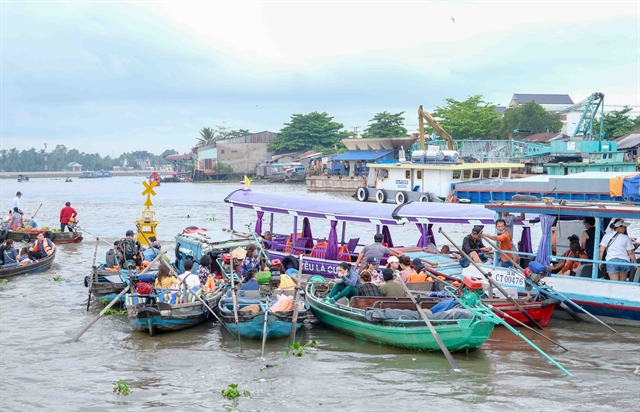 Society
Society

 |
| Cái Răng Floating Market is one of the most popular rural tourism destinations in Cần Thơ’s Cái Răng District. — VNA/VNS Photo Thanh Liêm |
CẦN THƠ — Cần Thơ City is developing tourism products related to agriculture and craft villages to improve rural incomes.
With over 114,000 hectares of farming areas, or 79 per cent of its total land area, the centrally run city in the Cửu Long (Mekong) Delta primarily cultivates rice and fruits, and engages in aquaculture, providing a solid foundation for the development of agricultural tourism.
It boasts various agricultural tourism models, including orchard tourism services.
Phong Điền District, for instance, with nearly 9,000 hectares under fruits, has established over 30 orchards and ecological tourism sites across Mỹ Khánh, Nhơn Ái and Nhơn Nghĩa communes and Phong Điền Town.
Phạm Văn Hoàng, who owns the 9 Hồng orchard in Mỹ Khánh Commune’s Mỹ Nhơn Hamlet, said he collaborated with neighbouring orchard owners to cater to tourists, offering activities such as fishing in ditches, traditional cake-making and local culinary experiences.
In Bình Thuỷ District, the community-based tourism model on Sơn riverine island has become a magnet for tourists due to its diverse offerings such as caged aquaculture, fruit orchards, traditional cake making, and performances by snakefish and frogs.
Located in the Hậu River, a tributary of the Mekong, the island is renowned for its vast fruit orchards and hospitable locals.
Beyond agriculture, Cần Thơ is also home to 12 craft villages such as the Thuận Hưng rice paper making village and Thơm Rơm fishing net weaving village in Thốt Nốt District, Ba Rích cake and candy making village in Ô Môn District and Phó Thọ - Bà Hộ flower and ornamental plant growing village in Bình Thuỷ District, which have garnered significant tourist interest in recent years.
Thuận Hưng was designated a national intangible cultural heritage site last year.
The city has 140 products rated three or four stars under the national “One Commune-One Product” (OCOP) programme, and their diverse range comprising vegetables, fruits, processed agricultural goods, tea, spices, and tourism products are popular among tourists.
Mỹ Khánh tourism village recently became the first four-star OCOP tourism product in the delta.
Established in 1996, the village offers various services such as fruit orchard tours, hands-on farming experiences and authentic local cuisine.
Despite progress, agricultural and craft village tourism products in the city remain fragmented, primarily revolving around fruit orchards.
Craft villages lack immersive activities for tourists and have not yet collaborated with travel agencies to develop comprehensive tours.
To address these challenges, the city is implementing a plan to develop agricultural tourism from 2021 to 2025.
It prioritises the development of agricultural tourism in specific districts and aims to ensure all agricultural tourism sites and products meet quality standards by 2025.
In addition to traditional agricultural tourism, the plan also seeks to develop urban agricultural tourism and high-tech agricultural tourism to keep tourists longer.
It focuses on creating high-quality, diverse tourism products that align with the city’s identity, create high added value and meet tourists’ expectations.
It also aims to create a skilled tourism workforce and pilot models for rural tourism development that are environmentally conscious and sustainable.
The Department of Agriculture and Rural Development will guide farmers in adopting clean and organic farming practices and promote the integration of rural tourism with agricultural tourism, craft villages, culture, and ecological conservation efforts.
Efforts will also be made to create linkages between producers of OCOP products and tourism providers to showcase the city’s OCOP and speciality products.
Tourist numbers have been increasing by an average of 12 per cent a year since 2010, with the city receiving 5.99 million visitors and generating total revenues of VNĐ5.4 trillion (US$221 million) last year. — VNS
 |
| Rice papers dry under the sun in Thuận Hưng village in Cần Thơ’s Thốt Nốt District. The city is developing agricultural and craft village tourism. — VNA/VNS Photo Thu Hiền |